
President, one of the many magazines covering economics and society here in Japan, discussed food poverty in the May issue.
While we may hear about "B-class gourme" schemes that highlight the usual popular ramen places or cheap udon, of course people know that there is more to nutrition and health. TV commercials and regular broadcasting will have no limit to their promotion of (imported) meat and wheat.
B-class food
President wonders why women are more interested in vegetables than men. The article also correlates income with healthy choices.
This needs much more investigation as we are in dire straits and less connection to the traditional, healthy diet in Japan.
What is clear from the President study is that more women will chose more vegetables in their diet, when they feel the pinch.
From Japan Guide:
Japanese cuisine
places a strong emphasis on quality and seasonality of ingredients.
This is especially true for vegetables, which are a fundamental element
of Japanese cooking.
See also our separate pages about mushrooms, seaweed, fruits and pickles.
Leaf Vegetables
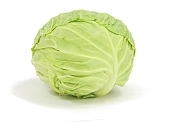
|
|
Cabbage
|
|
Cabbage is an inexpensive, versatile vegetable used to add nutrition and
flavor to a broad range of meals. Cabbage is often sliced into thin
strips to be served with korokke, tonkatsu (deep fried pork cutlet) or other fried dishes. It is also an important ingredient for okonomiyaki.
|
|
Cabbage can be added to just about any dish, from soups and stews to
pan-fried meals and side salads. Japan is one of the world's top cabbage
producers and the vegetable itself is one of the most frequently
purchased vegetables in Japanese supermarkets.
|
|
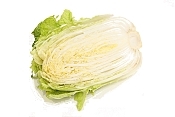
|
|
Hakusai (Chinese cabbage)
|
|
Hakusai is popular in many parts of Asia, where it is often pickled. In
Korea, hakusai is the cabbage variety usually used to make kimchi, the
nation's most famous dish.
|
|
In Japan, hakusai is also pickled in a dish known as hakusai no
sokusekizuke, which, however, is much milder than kimchi. Furthermore,
fresh hakusai is a very popular ingredient in hot pot (nabe) dishes.
|
|

|
|
Horenso (spinach)
|
|
Horenso enjoys popularity thanks to its health benefits and variety of vitamins, being particularly rich in calcium and iron.
|
|
A well known horenso dish is horenso no goma-ae (spinach with sesame dressing), which involves blanching the horenso and then mixing it with a sweet, soya sauce and sesame flavored dressing. Horenso is also used as a topping in soups.
|
|
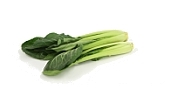
|
|
Komatsuna (Japanese mustard spinach)
|
|
Komatsuna is grown and consumed mostly in Japan, China, Taiwan and
Korea. It is similar to spinach, in that it contains many important
nutrients and vitamins, but it does not have the same bitterness as
spinach. Komatsuna is commonly eaten raw in salads or boiled and served
in soups and stews. It can also be pickled.
|
|

|
|
Mizuna (Japanese mustard, spider mustard)
|
|
Mizuna has recently become very popular as a salad leaf. It is
frequently paired with julienned daikon (giant white radish) in a fresh
tasting salad. Otherwise, mizuna may appear in soups or Japanese hot pot
(nabe), or as a garnish on various dishes.
|
|
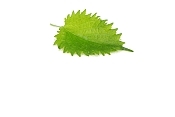
|
|
Shiso (Perilla leaf)
|
|
Shiso is a mint-like herb whose distinctive flavor is a staple in
Japanese cooking. It comes in two varieties which are used for different
purposes. Aojiso (green shiso) is often served with sashimi, in salads or to flavor soups and stews. Akajiso (red shiso) is used to pickle Japanese plums and add color to dishes.
|
|
Root Vegetables
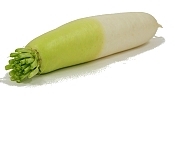
|
|
Daikon (giant white radish)
|
|
Daikon is a very popular and versatile Japanese vegetable. It can be
eaten raw or cooked or grated into daikon-oroshi, a refreshing topping
used to counteract the oiliness of dishes like grilled fish and tempura.
|
|
Especially the bottom half a daikon is often quite spicy like other
radish varieties. However, when cooked, this spiciness disappears and
the vegetable becomes slightly sweet.
|
|
When used raw, daikon is usually cut into julienne strips and paired
with mizuna leaves in a salad. When cooked, daikon is usually boiled in
soups, stews or hot pot (nabe) dishes . It is the most popular
ingredient in the oden hot pot.
|
|
Daikon also makes Japan's most popular pickle. Known as takuan, pickled daikon is included in virtually every dish of Japanese pickles. During the harvesting season, daikon hanging from farm houses in preparation for pickling is a common countryside sight.
|
|
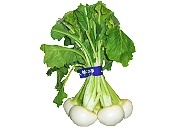
|
|
Kabu (turnip)
|
|
Kabu is almost always boiled and served in soups or Japanese hot pot, (nabe). It is a common miso soup ingredient and is often used to make pickles. Kabu usually have a spicier taste than Western varieties.
|
|

|
|
Jagaimo (potato)
|
|
Jagaimo were not part of traditional Japanese cuisine until relatively
recently. They are believed to have been brought by Dutch traders from
Indonesia to Kyushu
in the 17th century. However, potato cultivation in Japan did not begin
until the end of the 19th century. Today, jagaimo are closely
associated with Hokkaido where they are a regional specialty and common crop.
|
|
Jagaimo are popular in several Japanese dishes and adapted Western dishes. Nikujaga (meat and potato stew) combines beef, vegetables and potatoes in a sweet, soya sauce
flavored stew. Jaga batta is a popular festival food in which a
grilled potato is seasoned with butter and soya sauce. Jagaimo are also
common in Japanese curry and korokke.
|
|
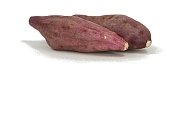
|
|
Satsumaimo (sweet potato)
|
|
Satsumaimo were originally grown in Kagoshima,
formerly called Satsuma. They are a popular winter vegetable used in
both sweet and savory dishes. Satsumaimo are often simply grilled,
peeled and eaten plain in a snack called yaki-imo. Satsumaimo may also
be battered and deep fried in tempura or boiled in soups, stews or Japanese curry.
|
|
Daigakuimo is a dish composed of candied satsumaimo. Its name comes from
the word for "university" because the snack was invented for university
students looking for cheap, tasty food. Because of their natural
sweetness, satsumaimo are sometimes made into sweets and snacks.
|
|
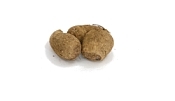
|
|
Satoimo (taro root)
|
|
Satoimo are eaten throughout Asia, especially in India, China, Korea and
Japan. They are a starchy root vegetable known for their somewhat
sticky, slimy texture.
|
|
Satoimo are always cooked before eaten, and typically appear in boiled or stewed dishes. Satoimo can be added to miso soup, Japanese hot pot (nabe), Japanese curry or appear battered and deep fried.
|
|
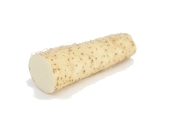
|
|
Nagaimo (yam)
|
|
Nagaimo and its wild mountain variety yamaimo are slightly different in
taste, texture and shape, but are prepared and consumed in the same way:
sliced and grilled, or eaten raw.
|
|
Raw nagaimo is grated to form a sticky, paste-like cream known as tororo. Tororo is used as a topping for rice,
soba or udon noodles, or mixed with dashi (fish stock) for flavor. Some
people experience a slight reaction when raw nagaimo comes in contact
with their skin. This can result in a tingling sensation around the
lips.
|
|
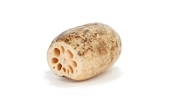
|
|
Renkon (lotus root)
|
|
Common in Japan and greater Asia, renkon's attractive pattern makes it a
useful vegetable for creating visually appealing dishes. It is not
usually eaten raw, but peeled and boiled in water. Depending on how long
it is cooked, lotus root may be crunchy like a fresh carrot, or starchy
and soft, like a cooked potato.
|
|
Renkon is often used in tempura,
boiled in soups or stewed dishes like chikuzenni, fried in pan-cooked
dishes or dressed with vinegar in a salad. It is almost always sliced to
show off its attractive pattern.
|
|

|
|
Gobo (burdock root)
|
|
Burdock plants exist all over the world, however, the vegetable is
mostly consumed in Asia and especially in Japan. Gobo grow to about one
to two meters in length and are cut before sold to make them more
manageable. Gobo are always cooked before eaten and are commonly added
to soups as a topping.
|
|
The most popular gobo dish is kinpira gobo, in which gobo and carrots
are shred into thin strips, stir fried and glazed with soya sauce, sugar
and sake.
|
|

|
|
Ninjin (carrot)
|
|
Ninjin are a widely available and popular vegetable in Japan. They are
often thicker than carrots seen in North American and European markets
although the taste is the same.
|
|
Like carrots in other parts of the world, ninjin are often enjoyed raw
in salads, or cooked into various dishes such as Japanese curry
and Japanese hot pot (nabe). Because of their bright color and sturdy
consistency, ninjin are often cut into decorative shapes or simply used
to add color and visual appeal to a dish.
|
|
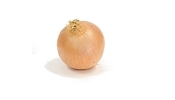
|
|
Tamanegi (onion)
|
|
Japan is one of the world's top onion producing countries, and onions are widely used in many Japanese dishes.
|
|
As in most other cuisines, onions are usually cooked before eaten, and
are a typical ingredient of many fried and stewed dishes such as
Japanese curry, various domburi (meals served over a bowl of rice), and Japanese hot pot (nabe). Onions may also be an ingredient in miso soup or grilled alongside meat in teppanyaki.
|
|

|
|
Shoga (ginger)
|
|
Ginger, originally imported from China, is commonly used in Japanese cuisine. It is a winter flavor, used to add heat to winter meals or served with fish to counter the "fishy" smell.
|
|
Grated ginger is sometimes served besides wasabi as a spice for certain types of sushi and sashimi and to add flavor or counter fishy aromas. Ground shoga is also often served on top of tofu for flavor.
|
|
Thinly sliced, pickled ginger, called gari, is served with sushi
and eaten in between pieces of sushi to clear the palate. Another kind
of pickled ginger, beni shoga, is commonly served with heavy meats or
fried foods such as yakisoba and tonkatsu. Beni shoga is a dark red
pickle with a stronger taste than gari.
|
|
Other Vegetables
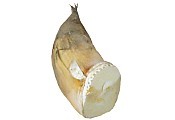
|
|
Takenoko (bamboo shoot)
|
|
Takenoko symbolizes spring more than any other vegetable. As its name
(lit. "child of bamboo") suggests, takenoko is the soft top of a young
bamboo plant. Takenoko must be harvested just before the plant peaks out
of the soil, otherwise it become hard and green.
|
|
Takenoko is consumed grilled, steamed with rice, deep fried in tempura, or boiled in soups and stews.
|
|
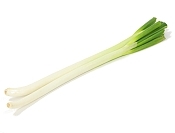
|
|
Negi (leek, green onion)
|
|
Negi are included in many fried and boiled dishes, or used as a topping for domburi (rice bowl) dishes such as gyudon (marinated beef over rice). Negi are usually described as having a taste similar to the green onion, though sweeter.
|
|
There are as many different varieties of negi as there are regions of Japan; however, the two most common are the Kanto variety with a long, white stem (see picture to the left) and the Kansai variety, whose stem is almost entirely green.
|
|

|
|
Tomato
|
|
In Japan, tomatoes are mostly eaten in Western style cooking, eaten raw
in salads or used as a garnish. While it is one of the most popular
vegetables in Japan, it is rarely cooked in Japanese dishes. For their
size and color, cherry tomatoes are especially popular in bento boxes.
|
|

|
|
Kyuri (cucumber)
|
|
Kyuri are usually thinner than Western cucumbers and are always eaten
unpeeled. They are commonly found raw in salads or as a garnish, or
pickled in an iced brine. Kyuri are a popular summer time vegetable.
|
|

|
|
Nasu (eggplant, aubergine)
|
|
Nasu are smaller and less bitter than their North American and European counterparts. They are an important vegetable in the Japanese cuisine and used in a wide variety of dishes.
|
|
"Nasu dengaku" is a typical dish in which the vegetable is cut in half and baked under a layer of miso paste. Another common dish featuring nasu is "nasu miso itame" in which the vegetable is fried with onions, miso and sugar.
|
|
Nasu has also a place in cultural folklore: Dreaming about Mount Fuji, a hawk or nasu on New Year
is considered good luck. And in a Japanese proverb, parents are warned
against giving nasu to their daughters-in-law in the fall.
|
|
This warning comes from the fact that fall nasu are particularly
delicious and are better kept to oneself. However, it also refers to the
fact that nasu are a "cooling" vegetable best eaten in the hot summer
months. Consequently, it is thought to deter pregnancy, thus being a
poor gift for a daughter-in-law.
|
|

|
|
Piman (Green pepper)
|
|
Piman comes from the French word for pepper, poivron. Japanese piman are
usually smaller than bell peppers. They have a thin skin and sweet
taste, and are often served battered and deep fried as tempura, or stir fried in Chinese style dishes. They are also eaten raw in salads.
|
|
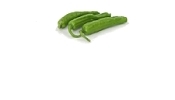
|
|
Shishito (Small Japanese green pepper)
|
|
Shishito are a smaller variety of piman, Japanese green peppers. They
are generally a sweet and mild pepper, although some varieties can be
quite spicy. Shishito are most commonly served as tempura or roasted and topped with soya sauce and bonito flakes.
|
|
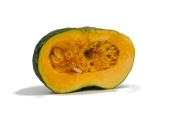
|
|
Kabocha (pumpkin)
|
|
Kabocha make their appearance in fall and winter. Kabocha's high
vitamin A content made it an important vegetable for northern Japan's
long winters.
|
|
Kabocha is traditionally eaten in celebration of the winter solstice,
the shortest day of the year, when people lack the nutrients found more
commonly in summer vegetables. Kabocha is often enjoyed as tempura or boiled in sugar and soya sauce resulting in a soft, sweet dish.
|
|
Recently, with the import of Halloween from North America, kabocha has
become a popular ingredient around the October 31 holiday, for example
in kabocha purin, sweet pumpkin pudding.
|
|

|
|
Tomorokoshi (corn)
|
|
Foreign visitors to Japan may notice the frequent addition of corn to Japanese breads, pizzas, pasta, salads and more.
|
|
Tomorokoshi is a popular vegetable in Japan, closely associated with Hokkaido,
where it is grown.
|
|
When tomorokoshi is in season, it is often grilled, buttered and seasoned with soya sauce. Tomorokoshi is also included in many Hokkaido specialty foods such a Hokkaido style ramen (noodle soup) and miso soup.
|
|

|
|
Okura (okra)
|
|
Okura has a sticky layer surrounding the seeds of its fruit, producing a
consistency similar to nagaimo (yam). When okura is consumed raw, the
sticky texture is present, however, it is cooked off when boiled or
fried.
|
|
Okura is a summer vegetable that is often eaten raw in salads, deep fried in tempura, or served with soya sauce and katsuobushi (smoked bonito flakes). Okura leaves are not commonly consumed in Japan.
|
|

|
|
Goya (bitter melon)
|
|
Goya is the most famous vegetables in Okinawan cuisine and the key ingredient in goya champuru, Okinawa's signature dish composed of stir fried goya, tofu and eggs. Goya is well known for its bitter taste.
|
|
 President, one of the many magazines covering economics and society here in Japan, discussed food poverty in the May issue.
President, one of the many magazines covering economics and society here in Japan, discussed food poverty in the May issue.





























Comments
Perhaps women are given more instruction about food - both preparation and nutrition while growing up and boys grow up to be food clueless. (We are clueless about a lot of things actually).
As for us men, I do wish we could do the right thing. What a mess we are in, all thanks to this recent meat-eating alpha-male ideology. Remember Shotoku-taishi?
As someone said, "nature bats last" - meaning that reality, or nature will always have the last word. Unfortunately, that's the hard way to learn!